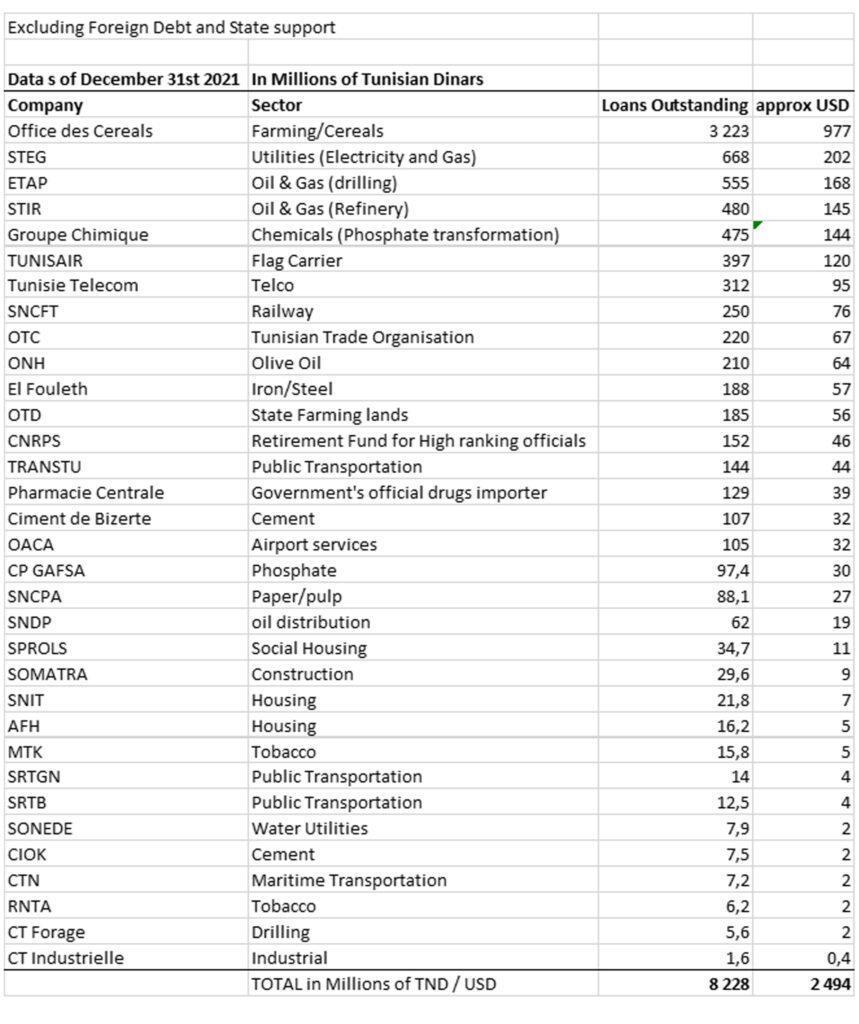In 2022, the twelve listed banks in the Tunisian stock exchange have realized an aggregate 6.224billion Tnd in Net Banking Income (NBI) approx. 2billion US Dollars meaning a 12.2% growth year on year.
NBI growth was mainly deriving from the following elements:
Operating charges were growing at a much lesser pace 5.4% meaning an additional 134 million Tnd in 2022 to reach a total of 2.605billion Tnd approx. 789million USD driven by payroll growth 3.6% to reach 1.787 billion Tnd) and 9.5% in the general operating charges to reach 818 million Tnd (250million USD)
Gross Operating Earnings, in aggregate, (before allocations to amortisation and before provisions and corporate taxes) have stood at 3.661billion Tnd approx. 1.1billion USD meaning a 17.2% growth year on year (3.123billion Tnd in 2021)
Based on the central bank’s statistics’ report the entire banks’ exposure to Gov Bonds (listed and non-listed banks ) has reached 16.5billion Tnd approx. 5billion USD to which we need to add the banks’ exposure to the State-Owned Enterprises (8.2 billion Tnd in loans) which puts the entire exposure in 2022 at 24.7billion Tnd approx. 7.5billion USD
Measured by the banks’ aggregate equity, their exposure to Gov Bonds is now at 108% of their equity (as of end of August 2022)
Income on portfolio for banks means interests earned on government bonds. On the interest margin side, the banks cater for the interests earned on loans granted to the state-owned enterprises (SOEs). Only when these SOEs are in difficulties and their loans are accounted as Non-Performing Loans (NPLs) that banks make provisions and stop earning interests on SOEs’ loans. When interests are accrued but not due, the banks still post these interests to their revenues although most of these loans are basically bad loans.
Loans to the economy:
According to the Central Bank’s statistics, the gross loans granted by the entire banking system to the economy (excluding Government Bonds and loans directly granted to the state) have reached 102.8billion Tnd (approx. 31.15 billion USD) as of end of August 2022
Loans to SOEs
Based of the data released by the ministry of finance the total loans granted by the banking system the 40 biggest SOEs (a sample of 40 companies that excludes the state-owned banks, the social security funds and the debt to the Town Halls and Postal Services, the entire bank debt to the SEOs stands at 8.28 billion Tnd (approx. 2.5billion USD)
List of SOEs and their loans’ exposure
NBI growth was mainly deriving from the following elements:
- Interest margin (+8.6%) at 3.093billion Tnd approx. 900 million USD
- Commissions (+4.8%) at 1.272billion Tnd approx. 385 million USD
- Income on government bonds/Dealing room/Dividends’ revenues (+24.9%) at 1.859billion Tnd approx. 563million USD
Operating charges were growing at a much lesser pace 5.4% meaning an additional 134 million Tnd in 2022 to reach a total of 2.605billion Tnd approx. 789million USD driven by payroll growth 3.6% to reach 1.787 billion Tnd) and 9.5% in the general operating charges to reach 818 million Tnd (250million USD)
Gross Operating Earnings, in aggregate, (before allocations to amortisation and before provisions and corporate taxes) have stood at 3.661billion Tnd approx. 1.1billion USD meaning a 17.2% growth year on year (3.123billion Tnd in 2021)
Based on the central bank’s statistics’ report the entire banks’ exposure to Gov Bonds (listed and non-listed banks ) has reached 16.5billion Tnd approx. 5billion USD to which we need to add the banks’ exposure to the State-Owned Enterprises (8.2 billion Tnd in loans) which puts the entire exposure in 2022 at 24.7billion Tnd approx. 7.5billion USD
Measured by the banks’ aggregate equity, their exposure to Gov Bonds is now at 108% of their equity (as of end of August 2022)
Income on portfolio for banks means interests earned on government bonds. On the interest margin side, the banks cater for the interests earned on loans granted to the state-owned enterprises (SOEs). Only when these SOEs are in difficulties and their loans are accounted as Non-Performing Loans (NPLs) that banks make provisions and stop earning interests on SOEs’ loans. When interests are accrued but not due, the banks still post these interests to their revenues although most of these loans are basically bad loans.
Loans to the economy:
According to the Central Bank’s statistics, the gross loans granted by the entire banking system to the economy (excluding Government Bonds and loans directly granted to the state) have reached 102.8billion Tnd (approx. 31.15 billion USD) as of end of August 2022
Loans to SOEs
Based of the data released by the ministry of finance the total loans granted by the banking system the 40 biggest SOEs (a sample of 40 companies that excludes the state-owned banks, the social security funds and the debt to the Town Halls and Postal Services, the entire bank debt to the SEOs stands at 8.28 billion Tnd (approx. 2.5billion USD)
List of SOEs and their loans’ exposure

NB: Courtesy Ilboursa, Tunisia’s number one financial website dated August 10th 2023